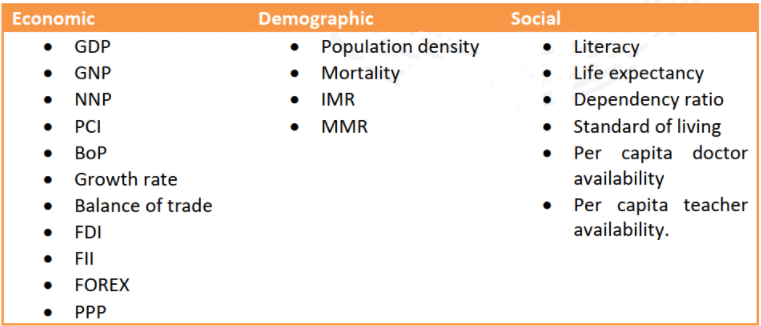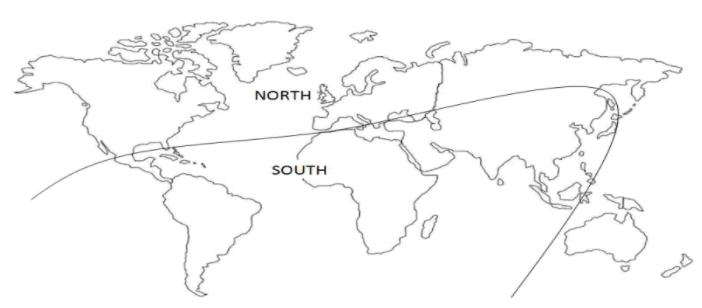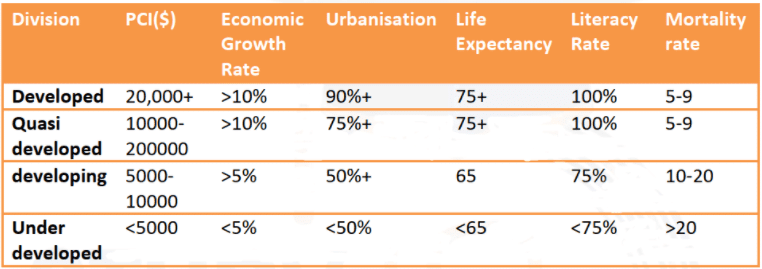World Economic Development: Measurement & Problems | Geography Optional for UPSC PDF Download
| Table of contents |

|
| Economic Geography vs Economics |

|
| World Economic Development |

|
| Economic Growth vs Development |

|
| Frequently Asked Questions (FAQs) of World Economic Development: Measurement & Problems |

|
Economic Geography vs Economics
- Economics is concerned with the policies and elements that contribute to the profitability of a specific organization, such as the costs of industrial inputs, outputs, and taxation.
- On the other hand, economic geography focuses on the factors that influence the location of a specific industry or organizational setup. It examines the spatial distribution and positioning of industries.
Economic Geography
Economic geography is a field of study that concentrates on the relationship between humans and their environment in terms of economic benefits. It examines the spatial distribution of resources, human economic activities, and the interaction between people and their surroundings. There are three main approaches in economic geography:
- Empirical approach: This method relies on direct observations of human activities in a specific location. However, it is not as popular in modern times.
- Functional approach: This approach studies the relationship between natural resources and human interaction. It seeks to answer questions like who gets what, where, and how.
- Environmental deterministic approach: According to this theory, human economic activities are determined by the natural environment, and the economic level is a result of physical conditions. However, this idea has become outdated due to technological advancements that allow humans to adapt to and overcome environmental challenges.
Economic geography is a sub-discipline of geography and can be divided into four main areas:
- Agricultural geography
- Industrial geography
- Transportation geography
- Development geography
In recent years, the primary focus of economic geography has been to understand the uneven economic development across the world. Geographers have shifted their attention from merely exploiting resources to studying geography that promotes human welfare.
World Economic Development
- The field of economic geography has evolved significantly since its inception in the late 19th century. Initially, it focused on the spatial location of commodities and raw materials, as well as their relation to physical geography and transportation networks. Over time, this approach shifted from being purely descriptive to incorporating economic theory, mainly derived from Neo-Classical economics.
- During the Quantitative Revolution phase, economic geographers began to recognize the limitations of these models in accurately reflecting the complexities of the real world. As a result, they started adopting theories that allowed them to focus on the social consequences of economic actions. In particular, Marxist theory, which suggests that the organization of production is closely linked to social structures, became influential in economic geography and human geography more broadly.
- In recent times, economic geography has continued to evolve, taking into account the dynamic nature of economic relationships and the influence of globalization. For example, the rapid development of the Pacific Rim's tiger economies and the impact of the Shell Oil Company in Nigeria's Niger Delta region illustrate these changes.
- Economic geographers have also placed increasing importance on analyzing the concentration of specific industries and land uses within certain regions. As the economies of industrialized countries shift towards consumer-based models, economic geography has begun to focus more on patterns of consumption and the sustainability of particular economic activities.
- In the past two decades, the field has become more critical and varied in its approach, with a greater emphasis on understanding the uneven distribution of wealth and well-being. This has led to a shift in focus from the geography of resource exploitation to the geography of human welfare, encompassing all parts of the world.
Economic Growth vs Development
Growth
- Economic growth refers to the quantitative aspect of an economy, with a focus on materialistic factors. It is measured using indicators such as GDP, GNP, NNP, and others, which are based on economic values including production, input, output, import, export, and monetary values. This often leads to a capitalistic society, where wealth is concentrated in the hands of a few, leading to disparities such as regional and interpersonal inequality.
- Economic growth is a time-based concept and relies on the vertical analysis of societal factors like sections and castes.
Development
On the other hand, economic development is a qualitative term that has a human-centered focus. It is assessed using human and social indicators such as per capita consumption, sex ratio, literacy rate, standard of living, life expectancy, mortality rates, and the Human Development Index (HDI). This approach leads to a more socialistic and welfare-oriented society. Economic development aims to achieve a balance across regions by promoting distributive justice and focusing on improving the conditions of poorer areas. It is a spatial concept that is based on historical analysis.
The Relationship Between Economic Growth and Development
- Although economic growth and development are distinct concepts, they cannot be separated entirely. Economic growth serves as a means to achieve development, which is the ultimate goal. Without economic growth, development would not be possible. Economic impulses are necessary to stimulate developmental progress.
- Economic growth is a prerequisite for the developmental process, and consistent growth can help spread development across different regions, reducing disparities. While economic growth initiates the process, development is the desired outcome. In summary, economic growth and development are interconnected concepts, with growth being the means to achieve the broader goal of development.
Indexes of measurement of economic development

Criticism of such measurements
- Criteria are more western-oriented.
- Data used in such measurement is not always reliable.
- There is ignorance of nomothetic values like culture and moral values.
Spatial pattern of economic development in the world
The spatial pattern of economic development refers to the distribution of economic growth and social progress across different regions of the world. This pattern is influenced by various geographical factors such as topography, climate, natural resources, population, socio-cultural and religious traits, political organization, institutional factors, mobilization of people, and advances in science and technology.
Generally, the world can be categorized into four main economic regions:
- Capitalistic-Commercial economies: These include countries like Belgium, the Netherlands, Switzerland, and Singapore, which have market-oriented economies and strong commercial sectors.
- Industrial-Commercial economies: Countries such as the USA, Japan, the UK, and Germany fall into this category, characterized by advanced industries and strong commercial sectors.
- Industrial-Agrarian economies: This category includes South American countries, Australia, New Zealand, Southeast Asian countries, and France, which have a mix of industrial and agricultural sectors.
- Agrarian-Rural economies: African countries, Cambodia, and Laos are examples of nations with predominantly agricultural and rural economies.
- Socialist countries: These are countries with centrally planned economies and state ownership of resources and industries.
Another way to classify the world's economies is by dividing them into developed, developing, and least-developed countries. This classification is based on factors such as GDP, per capita income, and the standard of living.
In addition to these divisions, the world can also be divided into the Global North and Global South based on economic development:
- Global North: These countries are characterized by market-oriented economies, advanced technologies, industrialization, and urbanization. They account for almost 90% of global trade (India's share, for example, is less than 1%).
- Global South: These countries mainly produce raw materials and have high population densities, low GDP, low per capita income, and low standards of living. They are often considered impoverished and underdeveloped.
In summary, the spatial pattern of economic development in the world is shaped by various geographical, socio-cultural, and political factors, leading to a diverse range of economies across the globe. Understanding these patterns is essential for addressing global economic disparities and promoting sustainable development for all.

- At meso level, the world economies can be divided into:
(i) Developed economies
(ii) Quasi developed economies such as South America, Russia, China, Brazil, Asian Tigers (Singapore, Malaysia, Thailand, Indonesia)
(iii) Developing
(iv) Underdeveloped
(v) Socialist - The UN criteria is as follows

At regional scale the world economies can be divided into
- Anglo-America (USA + Canada)
- These areas are resource rich such as iron ore coal and petroleum in USA, tin, fishing in Canada, etc.
- These countries are characterised by high level of development, high standard of living, good economic conditions, high technology, etc.
- They have high demographic and social indexes such as life expectancy, sex ratio, etc.
- Since human development in these countries is high, it leads to high technological and economic development, which are compatible with each other (though there are some areas in USA where human development is high but not economic development and vice versa due to racism)
- There are the events of environment and social hazards such as class differentiation, discrimination, etc)
- Latin America
- It consists of Mexico, Central America, Caribbean islands.
- It can be divided into two groups i.e. Quasi developed like Mexico and developing like countries of Central America and Caribbean islands.
- South America
- The countries of South America is both industrialised (not as high as Anglo America) and agrarian.
- The Per Capita Income of Brazil is $8000, Chile is $20,000
- South American society is divided into caste system based on racial texture such as
(i) Mestizos: European White+ Red Indians
(ii) Mullatos: European White +Black
(iii) Zambos: Red Indians + Black - Human development and economic development, both are in transitional stage. The discrimination against Mullatos and Zambos is however, in-humanitarian.
- Concentration of wealth is in few capitalistic hands and Mestizos occupy 90% of the natural resources.
- Sahara and Sub-Sahara Africa
- It includes Egypt, Sudan, Tunisia and Libya which are Islamic nations.
- Most of these countries have petroleum. Economic development is greater but human development is lacking.
- The Per Capita Income of Tunisia is $12000, Egypt is $6000 and Libya is $6000
- Meso Africa
- It includes the countries of middle Africa such as Congo, DRC, Uganda, Rwanda, Chad, Malawi, etc.
- These countries are marked by abundance of natural resources, but due to low technology their exploitation is low. There is lack of industries.
- These are mostly the tribal economies marked by civil strife.
- They are poor in both economic and human development.
- Eastern Africa
- These include Ethiopia, Kenya and Somalia
- These are one of the most poorest countries of the world
- Western Africa
- The countries of Western Africa includes Guinea Africa, Senegal, Sierra Leone, Ghana, Nigeria (developing)
- They are full of natural resources but are tribal economies.
- South-Central Africa
- It includes South Africa, Zambia, Zimbabwe, Namibia
- They are developing or quasi developed countries (South Africa)
- Asia
- South West Asia
(i) The economic development is high but human development is low since they are dominated by religious monarchs, lack of medical facilities and traditional societies.
(ii) They are petro dollar economies. Per Capita Income of Saudi Arabia is $23000, Kuwait is $45000, Iraq is $8000 to 9000, etc. - South East Asia
(i) These countries include Asian Tigers (Singapore, Malaysia, Thailand, and Indonesia).
(ii) They are the multicultural region of the world. - South Asia
(i) The countries of South Asia include India, Pakistan, Bangladesh, Sri Lanka, etc.
(ii) Both human and economic development is poor in these countries.
(iii) Maximum number of poor is there in India, though India has more rich than USA. - Far East
(i) It includes Japan, Korea, China, etc
(ii) They are both developed (Japan) developing nations (China, Korea, Taiwan, etc)
(iii) Per Capita Income of Japan is $35000, China is $6000.
- South West Asia
The economic development of a region is influenced by various factors, which can be categorized as follows:
- Physical factors (Geographical factors): These include climate, temperature, and rainfall. Regions with extreme climates, such as African nations, tend to be underdeveloped, while those with more favorable climates, like the USA, are more developed. Relief, structure, and topography also play a role, with mountainous areas being less developed than plains. Soil fertility, land capability, and productivity affect development, as regions with fertile soil and high land capability, such as the prairies, tend to be more developed than those lacking them. Drainage and hydrology also matter, as areas with better water availability are more developed. Accessibility and location are crucial, with port areas often being more developed due to their high accessibility. Natural resources are important, provided the region has efficient technological systems to harness them.
- Demographic factors: These include factors like mortality rate, sex ratio, dependency ratio, wage rate, and employment.
- Environmental factors (Geographical factors): Factors such as floods, droughts, climate change, and ozone depletion can affect a region's development. For example, Orissa is less developed than Mumbai due to more frequent environmental hazards.
- Technological factors: Technology plays a significant role in a region's development. For example, Japan has low natural resources but is a developed country due to its high level of technology. In contrast, Brazil, despite being rich in natural resources, is a developing nation due to its lack of technology.
- Dynamic factors: These include industrialization, urbanization, government policies, import-export, and the role of international institutions.
- Economic factors: These include the distribution of resources, availability of financial institutions, and access to credit facilities.
- Cultural and religious factors: Factors such as superstitions, societal outlooks, and religious beliefs can impact development.
- Social factors: These encompass social taboos, customs, traditions, caste and regional biases, literacy and education, food crisis, poverty, gender bias, and the attitudes and work ethic of the population.
- Historical factors: Some regions may be developed or underdeveloped due to their historical development patterns. For example, Chennai was developed by the British, while early centers of development may now be underdeveloped due to saturation.
In summary, the economic development of a region is a complex interplay of various factors, including geographical, demographic, environmental, technological, dynamic, economic, cultural, social, and historical aspects. Understanding and addressing these factors is crucial for promoting sustainable development and improving the quality of life for the population.
Conclusion
In conclusion, economic geography and economics are two interconnected fields of study that focus on different aspects of the economic world. While economics deals with the policies and elements that contribute to the profitability of organizations, economic geography examines the spatial distribution and positioning of industries. The world's economies can be classified based on various criteria, such as development level and geographic region, revealing a diverse and complex global economic landscape. Understanding these patterns is crucial for addressing economic disparities and promoting sustainable development worldwide.Frequently Asked Questions (FAQs) of World Economic Development: Measurement & Problems
What is the difference between economic geography and economics?
Economic geography focuses on the factors that influence the location of a specific industry or organizational setup, examining the spatial distribution and positioning of industries. In contrast, economics is concerned with the policies and elements that contribute to the profitability of a specific organization, such as the costs of industrial inputs, outputs, and taxation.
How has the field of economic geography evolved over time?
Initially, economic geography focused on the spatial location of commodities and raw materials, as well as their relation to physical geography and transportation networks. Over time, this approach shifted from being purely descriptive to incorporating economic theory, mainly derived from Neo-Classical economics. In recent times, economic geography has continued to evolve, taking into account the dynamic nature of economic relationships and the influence of globalization.
What is the difference between economic growth and economic development?
Economic growth refers to the quantitative aspect of an economy, focusing on materialistic factors and measured using indicators such as GDP, GNP, and NNP. Economic development, on the other hand, is a qualitative term with a human-centered focus, assessed using human and social indicators such as per capita consumption, sex ratio, literacy rate, and life expectancy.
How can the world's economies be categorized based on economic development?
The world's economies can be divided into developed, developing, and least-developed countries based on factors such as GDP, per capita income, and the standard of living. Another way to classify the world's economies is by dividing them into the Global North and Global South based on economic development.
What are some criticisms of the measurements used to assess economic development?
Some criticisms of these measurements include that the criteria are more western-oriented, the data used in such measurements is not always reliable, and there is ignorance of nomothetic values like culture and moral values.
|
303 videos|636 docs|252 tests
|
FAQs on World Economic Development: Measurement & Problems - Geography Optional for UPSC
| 1. What is the difference between economic geography and economics? |  |
| 2. How does world economic development differ from economic growth? |  |
| 3. What are some challenges in measuring world economic development? |  |
| 4. How does economic geography influence world economic development? |  |
| 5. What are some key measures used to assess world economic development? |  |
















